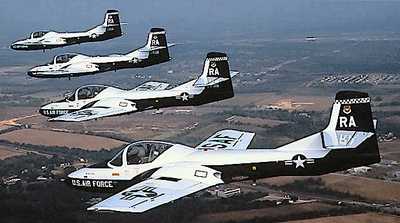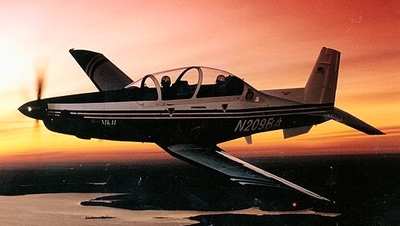And No, That Doesn't Mean A Message Sent On Twitter
 More than 50 years of
service is a lot to ask, especially from a tool used to train
thousands of people in a critical and sometimes dangerous business.
But as men and women in the U.S. Air Force said farewell to the
T-37 Tweet July 31, they did so knowing they got all they asked for
and more from the venerable training aircraft.
More than 50 years of
service is a lot to ask, especially from a tool used to train
thousands of people in a critical and sometimes dangerous business.
But as men and women in the U.S. Air Force said farewell to the
T-37 Tweet July 31, they did so knowing they got all they asked for
and more from the venerable training aircraft.
Among those who came to Sheppard to usher out the end of an era
and welcome in a new technological advancement in undergraduate
pilot training was Gen. Donald J. Hoffman, commander of Air Force
Materiel Command. His story, like many of those who came before and
after him, includes the Tweet, a durable and rugged training
platform that provided the foundation of more than 78,000 Air
Force, NATO and other international pilots since it became
operational in 1957.
The general, who "owns" the final destination of the Tweet --
the "Boneyard" at Davis-Monthan Air Force Base, Ariz., and home to
the Aerospace Maintenance and Regeneration Group, or AMARG -- said
his last flight in the Tweet is one that holds a special place in
his heart. Not only because of its heritage, but because it was the
beginning of his 35-year Air Force career.

T-37 Formation
His first active assignment was as an 80th Flying Training Wing
instructor pilot at Sheppard. "Because I flew the Sheppard jets
during my first assignment, and now have the Boneyard at Tucson as
part of Air Force Materiel Command, I have a close sense of
identity with the final retirement of this wonderful aircraft,"
General Hoffman said. "Nothing compares to the feeling of stepping
out of the aircraft and launching your student on their first solo
... you can almost see their grin coming out from the edges of
their oxygen mask."
The general is part of the group that will take four aircraft to
AMARG. Another group will take a couple to the Utah Test and
Training Range located at Hill AFB, Utah.
But why has the T-37 been such a dependable beginning trainer
for so many pilots?
"For most students, the T-37 is the first jet, the first
ejection seat, the first helmet and oxygen mask, and the first
formal Air Force flying syllabus they have been exposed to,"
General Hoffman said. "This can be an intimidating experience, but
they get the ground training, simulator training and personalized
attention of the instructor to get them through it."
General Hoffman, the leader in charge of providing the
acquisition management services and logistics support required to
develop, procure and sustain Air Force weapon systems, said there
is a more-than-viable option to replace the Tweet, the T-6A Texan
II.
"The T-6 is a highly capable replacement for the venerable
T-37," he said. "We are still going through some growing pains, but
it is much better suited to prepare student pilots for today's
aircraft and those that will come in the future."
The Texan II provides a tandem cockpit configuration similar to
two-seater fighter setups compared to the side-by-side T-37. It
also has a "glass cockpit," or all digital instrument panel.
General Kendall said should not be concerned about moving from a
jet powered aircraft to a single turbo-prop platform.

T-6A Texan II
"Some might think it unusual or a step backwards to replace a
jet aircraft with a prop-driven one," he said, "but let me say that
this is not your granddaddy's T-6. This primary flight trainer
outperforms the over 50-year-old flying 'birdwhistle' in just about
every area except perhaps in noise generation."
ANN salutes John Ingle, 82nd Training Wing Public Affairs
 ANN's Daily Aero-Term (05.17.24): Very High Frequency
ANN's Daily Aero-Term (05.17.24): Very High Frequency ANN's Daily Aero-Linx (05.17.24)
ANN's Daily Aero-Linx (05.17.24) ANN FAQ: Submit a News Story!
ANN FAQ: Submit a News Story! Classic Aero-TV: ANN Visits Wings Over The Rockies Exploration Of Flight
Classic Aero-TV: ANN Visits Wings Over The Rockies Exploration Of Flight Airborne Affordable Flyers 05.16.24: PRA Runway, Wag-Aero Sold, Young Eagles
Airborne Affordable Flyers 05.16.24: PRA Runway, Wag-Aero Sold, Young Eagles





